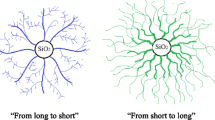Abstract
We modified silica nanoparticles with a N′-(3-trimethoxysilylpropyl)diethylenetriamine (TPDT) silane coupling agent, which has one primary and two secondary amino groups in each molecule, to introduce amino groups on silica surfaces. After surface modification of silica, we used an acrylate group containing 3-(acryloyloxy)-2-hydroxypropyl methacrylate (AHM) to introduce free radical polymerizable methacrylate groups by the aza-Michael addition reaction. Fourier transform infrared spectroscopy (FTIR), elemental analysis (EA), liquid state 1H and 13C nuclear magnetic resonance spectroscopy (NMR) and solid state cross polarization magic angle spinning (CP/MAS) 29Si NMR were used to investigate the effects of various reaction conditions on the degree of reaction between the N-H groups of the TPDT-modified silica surface and the acrylate groups of AHM. We found that approximately 48% of the N-H groups of the TPDT-modified silica surface reacted with the acrylate groups of AHM, compared with approximately 83% of the N-H groups of pure TPDT reacting with the acrylate groups of AHM at the same reaction conditions. This lower degree of the aza-Michael addition reaction between the N-H groups of the TPDT grafted on the solid silica particle versus the N-H groups of pure TPDT, both with acrylate groups of liquid AHM, may be caused by the lower mobility of the N-H groups of the grafted TPDT on the solid silica particle and the higher steric hindrance caused by the solid silica particle.
Similar content being viewed by others
References
N. Rakhshan and M. Pakizeh, Korean J. Chem. Eng., 32, 2524 (2015).
S.W. Kim, Korean J. Chem. Eng., 28, 298 (2011).
S. M. Senani, C. Bonhomme, F. Ribot and F. Babonneau, J. Sol-Gel Sci. Technol., 50, 152 (2009).
E. F. Vansant, P. Van der Voot and V. C. Vrancjen, in Characterization and Chemical Modification of the Silica Surface, Elsevier, Amsterdam (1995).
R.H. Halvorson, R. L. Erickson and C. L. Davidson, Dent. Mater., 19, 327 (2003).
S. Lee and K. Ha, Polymer (Korea), 38, 257 (2014).
H. N. Jeon and K. Ha, Polymer (Korea), 36, 668 (2012).
T. Ishii, S. Fujioka, Y. Sekiguchi and H. Kotsuki, J. Am. Chem. Soc., 126, 9558 (2004).
B.D. Mather, K. Viswanathan, K. M. Miller and T. E. Long, Prog. Polym. Sci., 31, 487 (2006).
Gelest, Inc., Silane Coupling Agents, Mossisville, PA, USA, 3 (2006).
E. Satu, I. L. Eero and N. Lauri, J. Phys. Chem. B, 108, 9650 (2004).
G.K. Dirk and B. Thomas, Langmuir, 11, 3061 (1995).
T. Hooshmand, R.V. Noort and A. Keshvad, Dent. Mater., 20, 635 (2004).
S.H. Yoo, H. J. Song and C. K. Kim, Polymer (Korea), 36, 721 (2012).
J. P. Matinlinna, S. Areva, V. J. Lassila and P. K. Vallittu, Surf. Interface Anal,, 36, 1314 (2004).
M. Michell, M. Tania, B. Guido, C. Lucia, C. Giovanna, C. Maila and T. Antonio, J. Phys. Chem. B, 108, 3563 (2004).
M.-C. B. Salon, M Abdelmouleh, S. Boufi, M. N. Belgacem and A. Gandini, J. Colloid Interface Sci., 289, 249 (2005).
M.-C. B. Salon, G. Gerbaud, M. Abdelmouleh, C. Bruzzese, S. Boufi and M.N. Belgacem, Magn. Reson. Chem., 45, 473 (2007).
J. Kamer, A. Scholten, W. L. Driessen and J. Reedijk, Eur. J. Inorg. Chem., 6, 1488 (2002).
D.W. Mayo, F. A. Miller and R.W. Hannah, Course Notes on the Interpretation of Infrared and Raman Spectra, Wiley, Hoboken, New Jersey, Chap. 7 (2004).
L. Martin, J.O. Osso, S. Ricart, A. Roig, O. Garcia and R. Sastre, J. Mater. Chem., 18, 207 (2008).
W. Decheng, L. Ye, H. Chaobin, C. Taishung and G. Suathong, Macromolecules, 37, 6763 (2004).
S.B. Zeynep, D.O. Oznur, I. Mehtap and A. Duygu, J. Polym. Sci. Part A: Polym. Chem., 49, 5042 (2011).
Author information
Authors and Affiliations
Corresponding author
Rights and permissions
About this article
Cite this article
Lee, S., Ha, K. Spectroscopic analysis of methacrylate groups introduced on silica particle surfaces by the aza-Michael addition reaction. Korean J. Chem. Eng. 33, 2469–2477 (2016). https://doi.org/10.1007/s11814-016-0150-2
Received:
Accepted:
Published:
Issue Date:
DOI: https://doi.org/10.1007/s11814-016-0150-2




